The Design and Impact of Interactive Online Modules for Dental Faculty Calibration
Abstract
1. Introduction
- What was faculty’s perceived effectiveness of the self-paced online approach?
- What were faculty’s level of participation and engagement with the online modules?
- How did participating in the online calibration modules impact faculty’s teaching behaviors?
2. Methods
2.1. Interactive and Gamified Online Design
2.2. Online Module Delivery
2.3. Online Module Evaluation
2.3.1. Online Survey
2.3.2. Platform Analytics
2.3.3. Supplementary Insights
3. Results
3.1. Faculty’s Participation in the Online Modules
3.2. Faculty’s Perceived Effectiveness of the Online Approach
“The SoftChalk format was easy to navigate, and it was different from all other CE courses we have at the dental school-it was much more engaging.”
“Online calibration courses are an easy option for scheduling purposes. They are more fun and more efficient.”
“All of these faculty calibration courses have been excellent. Exceptionally good quality and content for entirely online courses!”
“This is very good way to engage all faculty in learning and staying abreast with new important information from other than his/her own specialties.”
“While online learning may be adequate for some topics, many topics in clinical dentistry are taught with deeper understanding and retention of information when there is an opportunity for peer interaction and discussion.”
“The program does not provide an opportunity for discussion. It would be nice to see what questions other faculty may have or would like to discuss further. Maybe have a space where all faculty can post questions.”
3.3. Impact on Faculty’s Teaching Behaviors
4. Discussions
4.1. Faculty’s Perceived Effectiveness of the Online Format
4.2. Enhanced Flexibility and Inclusiveness
4.3. Challenges and Lessons Learned
4.4. Limitations and Future Directions
5. Conclusions
Author Contributions
Funding
Institutional Review Board Statement
Informed Consent Statement
Data Availability Statement
Acknowledgments
Conflicts of Interest
References
- Garland, K.V.; Newell, K.J. Dental hygiene faculty calibration in the evaluation of calculus detection. J. Dent. Educ. 2009, 73, 383–389. [Google Scholar] [CrossRef] [PubMed]
- Lanning, S.K.; Pelok, S.D.; Williams, B.C.; Richards, P.S.; Sarment, D.P.; Oh, T.J.; McCauley, L.K. Variation in periodontal diagnosis and treatment planning among clinical instructors. J. Dent. Educ. 2005, 69, 325–337. [Google Scholar] [CrossRef] [PubMed]
- Marini, L.; Tonetti, M.S.; Nibali, L.; Rojas, M.A.; Aimetti, M.; Cairo, F.; Cavalcanti, R.; Crea, A.; Ferrarotti, F.; Graziani, F.; et al. The staging and grading system in defining periodontitis cases: Consistency and accuracy amongst periodontal experts, general dentists and undergraduate students. J. Clin. Periodontol. 2021, 48, 205–215. [Google Scholar] [CrossRef] [PubMed]
- Sharaf, A.A.; AbdelAziz, A.M.; El Meligy, O.A. Intra- and inter-examiner variability in evaluating preclinical pediatric dentistry operative procedures. J. Dent. Educ. 2007, 71, 540–544. [Google Scholar] [CrossRef] [PubMed]
- Tabassum, A.; Alhareky, M.; Madi, M.; Nazir, M.A. Attitudes and satisfaction of dental faculty toward calibration: A cross-sectional study. J. Dent. Educ. 2022, 86, 714–720. [Google Scholar] [CrossRef] [PubMed]
- Oh, S.L.; Yang, J.S.; Kim, Y.J. Discrepancies in periodontitis classification among dental practitioners with different educational backgrounds. BMC Oral Health 2021, 21, 39. [Google Scholar] [CrossRef] [PubMed]
- Werner, J.L.; Hendry, G.D. Consistency in dental clinical feedback to students: Clinical teachers’ perspectives. Health Educ. Pract. J. Res. Prof. Learn. 2020, 3, 27–38. [Google Scholar] [CrossRef]
- Seabra, R.C.; Costa, F.O.; Costa, J.E.; Van Dyke, T.; Soares, R.V. Impact of clinical experience on the accuracy of probing depth measurements. Quintessence Int. 2008, 39, 559–565. [Google Scholar]
- Henzi, D.; Davis, E.; Jasinevicius, R.; Hendricson, W. In the students’ own words: What are the strengths and weaknesses of the dental school curriculum? J. Dent. Educ. 2007, 71, 632–645. [Google Scholar] [CrossRef]
- Dicke, N.L.; Hodges, K.O.; Rogo, E.J.; Hewett, B.J. A survey of clinical faculty calibration in dental hygiene programs. J. Dent. Hyg. 2015, 89, 264–273. [Google Scholar]
- Xu, X.; Xie, Q.; Zhou, Y.; Wu, L.; Cao, Y. Effect of a standardized training with digital evaluation on the improvement of prosthodontic faculty’s performance in crown preparation: A pre-post design. J. Prosthodont. 2020, 29, 766–771. [Google Scholar] [CrossRef]
- Commission on Dental Accreditation. Accreditation Standards for Dental Education Programs; Commission on Dental Accreditation: Chicago, IL, USA, 2022; Available online: https://coda.ada.org/standards (accessed on 15 December 2023).
- Brame, J.L.; AlGheithy, D.S.; Platin, E.; Mitchell, S.H. Use of a self-instructional radiographic anatomy module for dental hygiene faculty calibration. J. Dent. Hyg. 2017, 91, 5–13. [Google Scholar] [PubMed]
- Woo, D.A. An innovative online approach to clinical faculty calibration. J. Dent. Educ. 2021, 85 (Suppl. S1), 1059. [Google Scholar] [CrossRef] [PubMed]
- Carter, B.B. Faculty Calibration with Instructional Videos for Head and Neck Examinations. Master’s Thesis, The University of North Carolina at Chapel Hill, Chapel Hill, NC, USA, 2017. [Google Scholar]
- Zheng, M.; Bender, D.; Reid, L.; Milani, J. An interactive online approach to teach evidence-based dentistry with Voicethread. J. Dent. Educ. 2017, 81, 995–1003. [Google Scholar] [CrossRef] [PubMed]
- Zheng, M.; Bender, D.; Lyon, C. Online learning during COVID-19 pandemic produced equivalent or better student course performance as compared with pre - pandemic: Empirical evidence from a school-wide comparative study. BMC Med. Educ. 2021, 21, 295. [Google Scholar] [CrossRef] [PubMed]
- Moazami, F.; Bahrampour, E.; Azar, M.R.; Jahedi, F.; Moattari, M. Comparing two methods of education (virtual versus traditional) on learning of Iranian dental students: A post-test only design study. BMC Med. Educ. 2014, 14, 45. [Google Scholar] [CrossRef]
- Power, J.E.; Toft, L.; Barrett, M. The murmur online learning experience (MOLE) curriculum improves medical students’ ability to correctly identify cardiac murmurs. MedEdPORTAL 2020, 16, 10904. [Google Scholar] [CrossRef]
- Potomkova, J.; Mihal, V.; Cihalik, C. Web-based instruction and its impact on the learning activity of medical students: A review. Biomed. Pap. Med. Fac. Univ. Palacky Olomouc Czech Repub. 2006, 150, 357–361. [Google Scholar] [CrossRef]
- Haj-Ali, R.; Feil, P. Rater reliability: Short-and long-term effects of calibration training. J. Dent. Educ. 2006, 70, 428–433. [Google Scholar] [CrossRef]
- Jacks, M.E.; Blue, C.; Murphy, D. Short-and long-term effects of training on dental hygiene faculty members’ capacity to write SOAP notes. J. Dent. Educ. 2008, 72, 719–724. [Google Scholar] [CrossRef]
- Lanning, S.K.; Best, A.M.; Temple, H.J.; Richards, P.S.; Carey, A.; McCauley, L.K. Accuracy and consistency of radiographic interpretation among clinical instructors in conjunction with a training program. J. Dent. Educ. 2006, 70, 545–557. [Google Scholar] [CrossRef] [PubMed]
- Oh, S.L.; Liberman, L.; Mishler, O. Faculty calibration and students’ self-assessments using an instructional rubric in preparation for a practical examination. Eur. J. Dent. Educ. 2018, 22, e400–e407. [Google Scholar] [CrossRef] [PubMed]
- Oliveira, D.; Guha, U.; Delgado, A.; Ribeiro, A.P. Overcoming the emerging challenges in faculty calibration in times of COVID-19 pandemic. J. Dent. Educ. 2021, 85, 1078–1079. [Google Scholar] [CrossRef] [PubMed]
- Roy, D.; Sargeant, J.; Gray, J.; Hoyt, B.; Allen, M.; Fleming, M. Helping family physicians improve their cardiac auscultation skills with an interactive CD-ROM. J. Contin. Educ. Health Prof. 2002, 22, 152–159. [Google Scholar] [CrossRef] [PubMed]
- Collier, A.; Einstein, A. Engaging students in online environments. In BF Tobolowsky, Paths to Learning: Teaching for Engagement in College; University of South Carolina: Columbia, SC, USA, 2014; pp. 115–134. [Google Scholar]
- Kirkpatrick, J.D.; Kirkpatrick, W.K. Kirkpatrick’s Four Levels of Training Evaluation; Association for Talent Development: Alexandria, VA, USA, 2016. [Google Scholar]
- Hotzler, B. The Effect of Incorporating Active Learning in Calibration Exercises on Intra and Interrater Reliability among Dental Hygiene Faculty; The University of Minnesota: Twin Cities, MN, USA, 2019; Available online: https://hdl.handle.net/11299/208931 (accessed on 15 December 2023).
- Davis, F.D. Perceived usefulness, perceived ease of use, and user acceptance of information technology. MIS Q. 1989, 13, 319–340. [Google Scholar] [CrossRef]
- Zheng, M.; Bender, D.; Nadershahi, N. Faculty development in pedagogy for instructional innovation in dental education. Eur. J. Dent. Educ. 2017, 21, 67–78. [Google Scholar] [CrossRef]
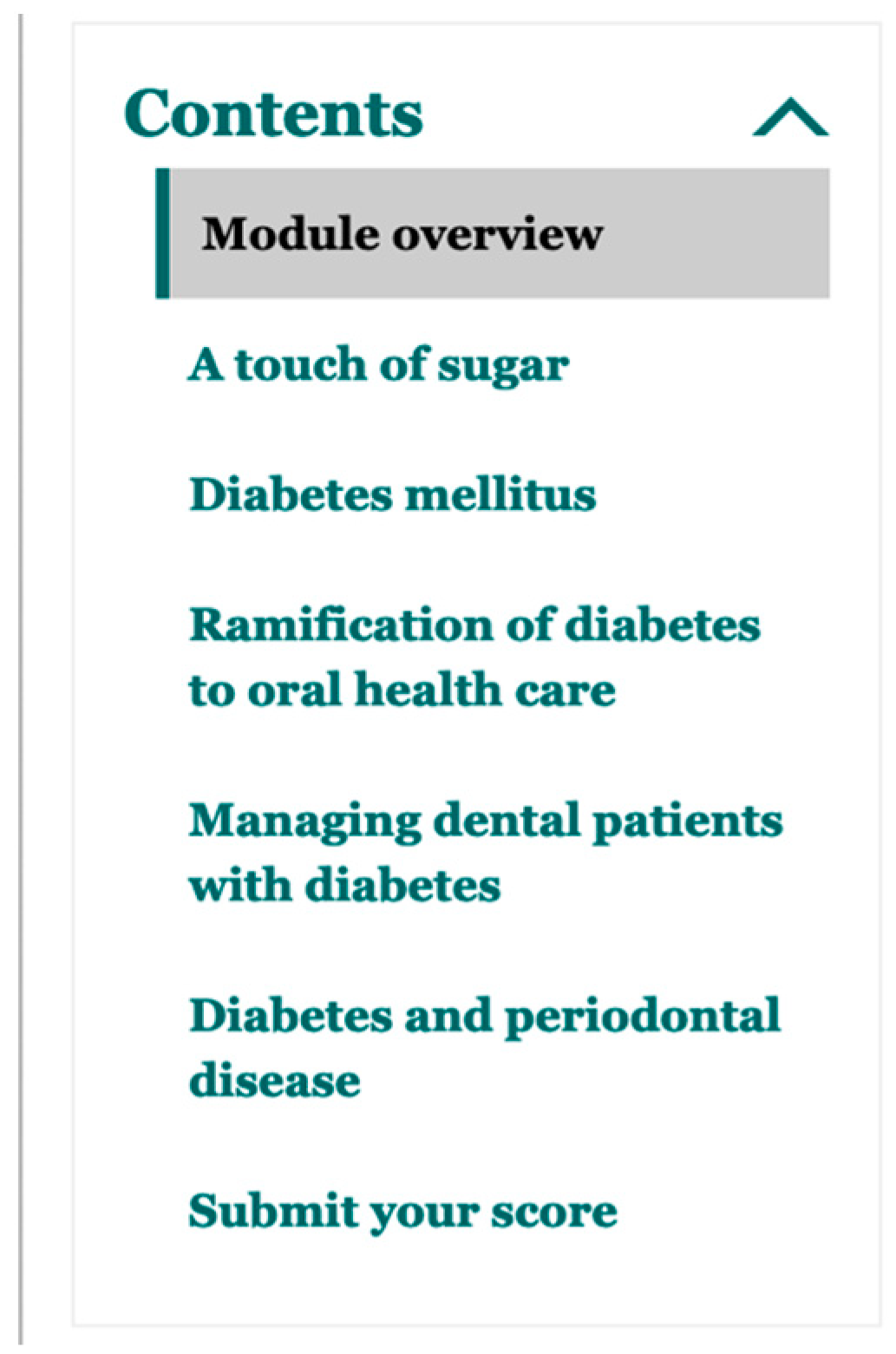
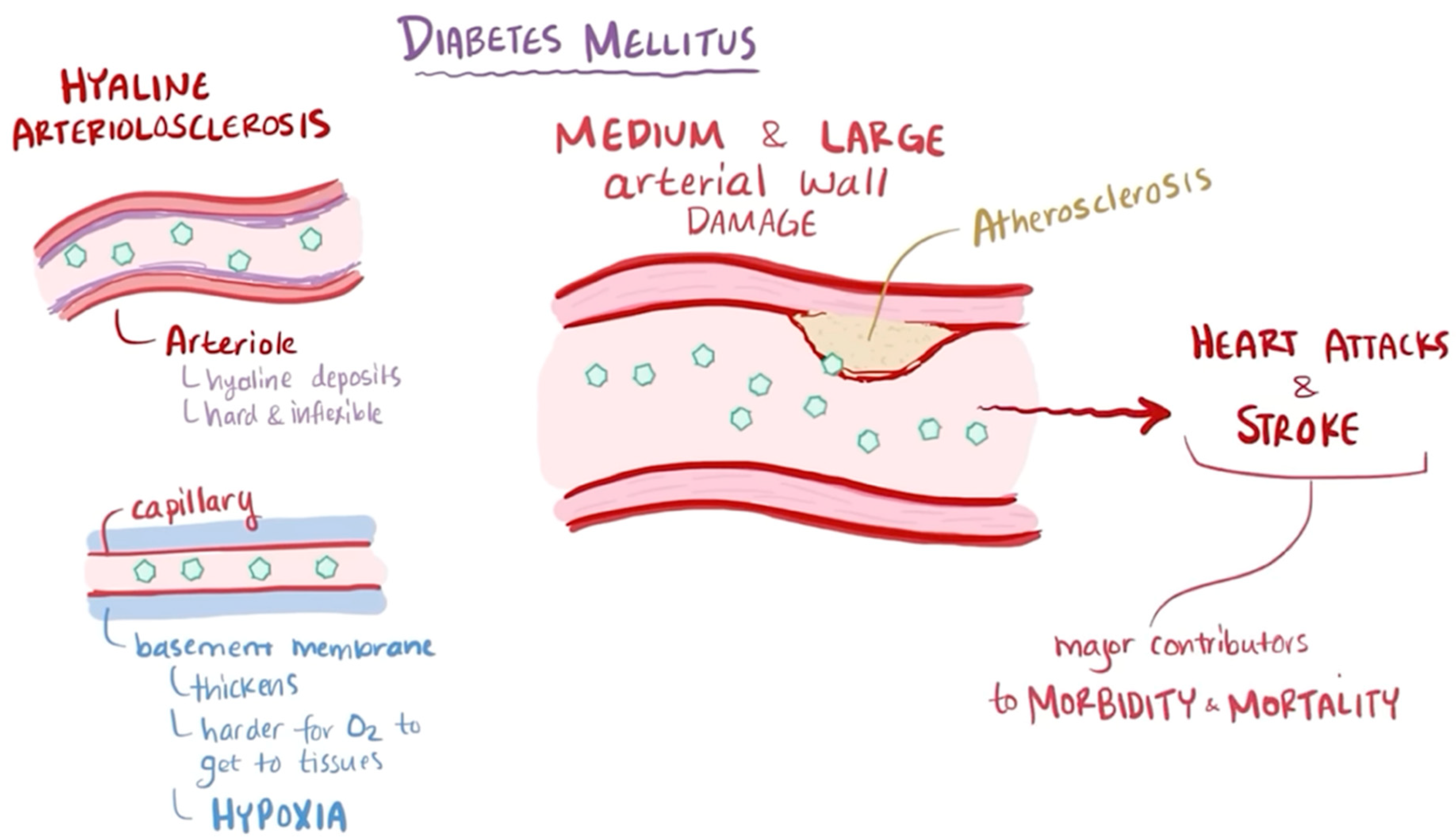
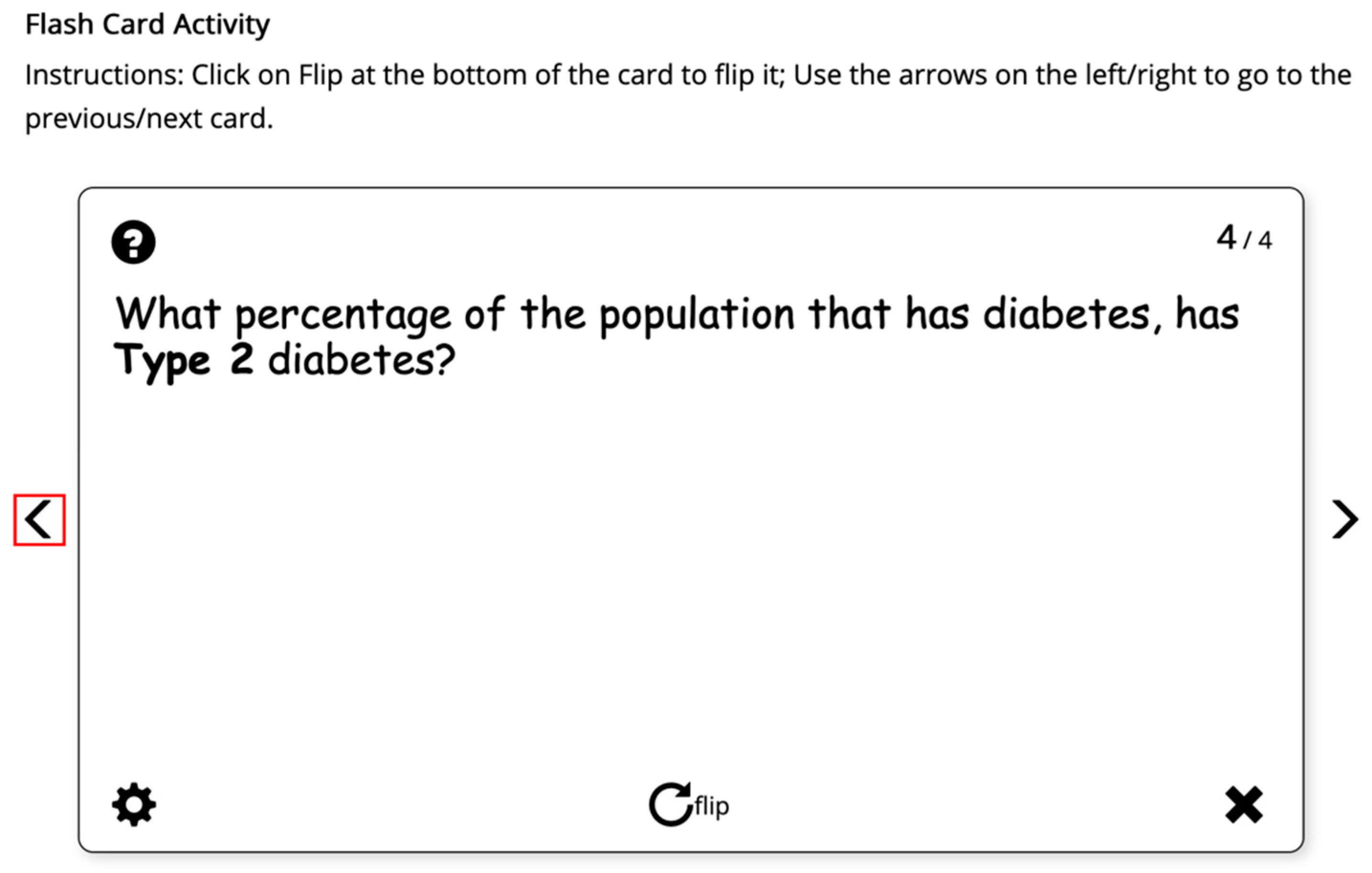
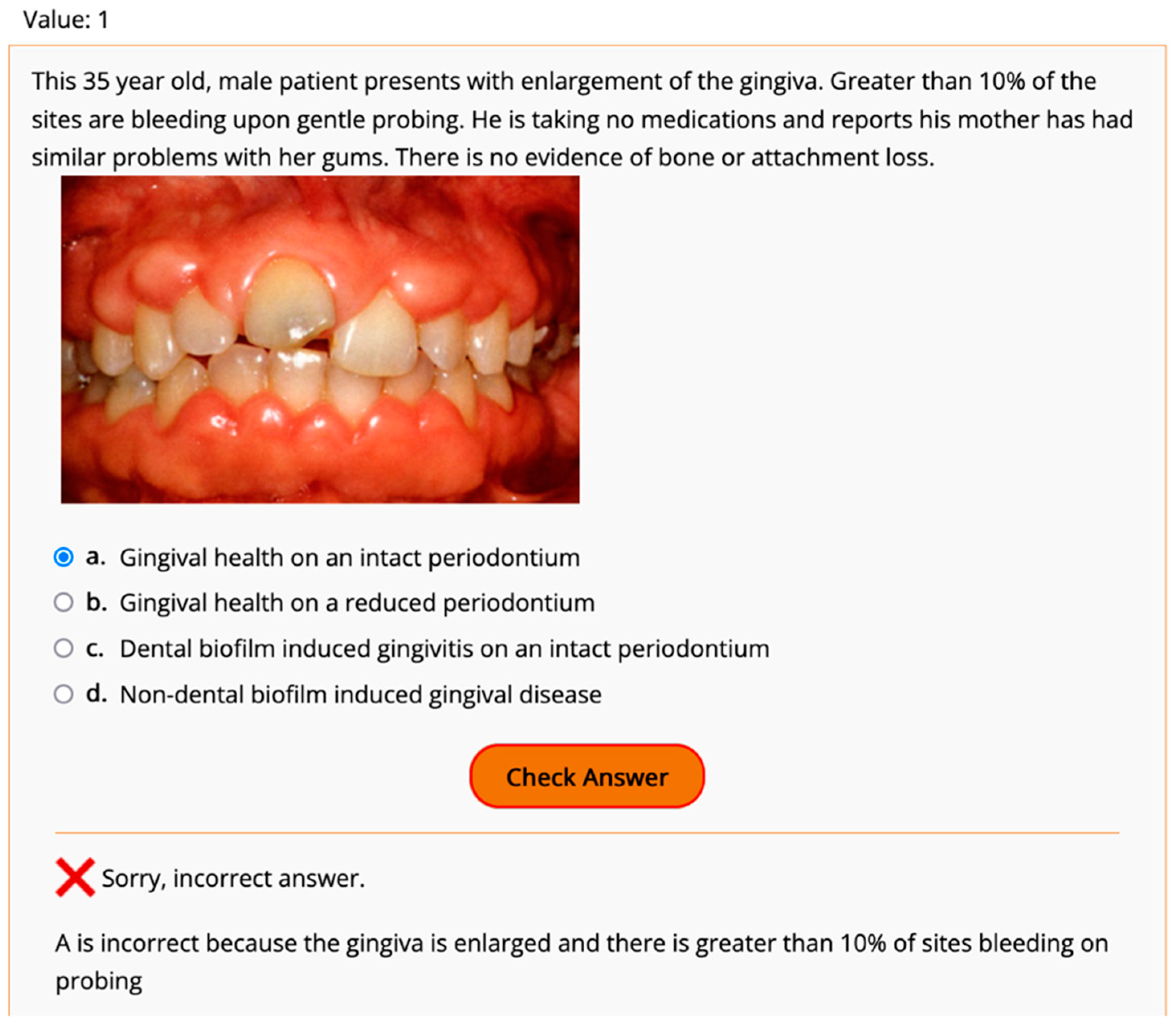
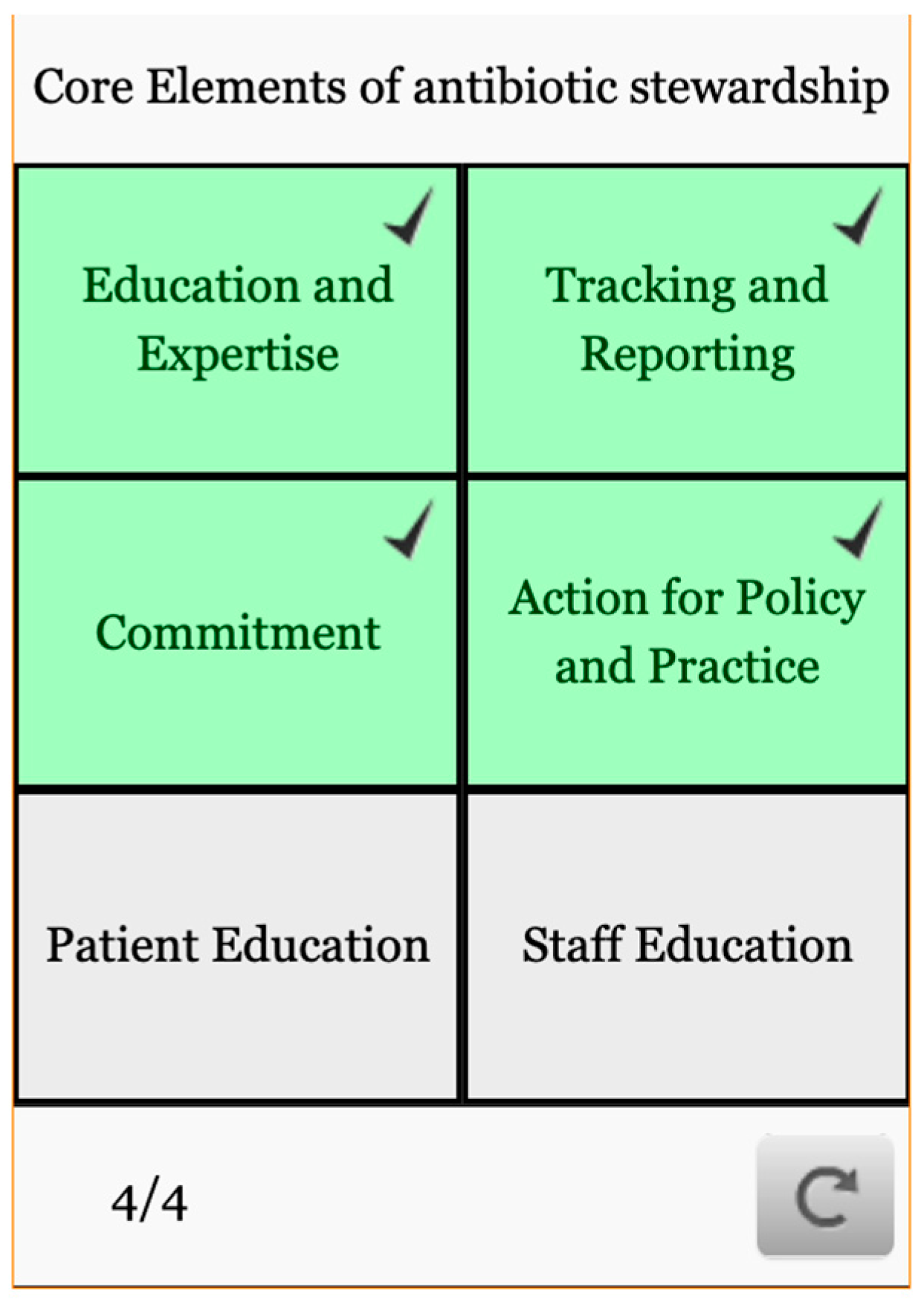
| Salaried Faculty (Full and Part-Time; n = 211) | Non-Salaried Faculty (Adjunct; n = 267) | Total (N = 478) | ||||
|---|---|---|---|---|---|---|
| Finished | Passed | Finished | Passed | Finished | Passed | |
| Module 1 Oral pathology consultations and diagnosis of oral lesions (Pass: 29 out of 31 points) | 120 (56.87%) | 117 (55.45%) | 81 (30.33%) | 70 (26.21%) | 201 (42.05%) | 187 (39.12%) |
| Module 2 Diabetic patients in dental clinic (Pass: 21 out of 24 points) | 104 (49.28%) | 97 (45.97%) | 73 (27.34%) | 68 (25.47%) | 177 (37.03%) | 165 (34.52%) |
| Module 3 Antibiotic stewardship in dentistry (Pass: 19 out of 23 points) | 93 (44.08%) | 88 (41.70%) | 68 (25.47%) | 65 (24.34%) | 161 (33.68%) | 153 (32.01%) |
| Module 4 Periodontal disease classification system (Pass: 9 out of 10 points) | 83 (39.34%) | 83 (39.34%) | 77 (28.84%) | 72 (26.97%) | 160 (33.47%) | 155 (32.43%) |
| Number of Respondents | Computer-Skill | |||
|---|---|---|---|---|
| Module 1: Oral pathology consultations and diagnosis of oral lesions | Full-time | 29 | Poor | 3 (3.06%) |
| Part-time | 44 | Fair | 24 (24.49%) | |
| Adjunct | 26 | Good | 45 (45.92%) | |
| Excellent | 26 (26.53%) | |||
| Module 2: Diabetic patients in dental clinic | Full-time | 28 | Poor | 4 (4.21%) |
| Part-time | 40 | Fair | 22 (23.16%) | |
| Adjunct | 28 | Good | 44 (46.32%) | |
| Excellent | 25 (26.32%) | |||
| Module 3: Antibiotic stewardship in dentistry | Full-time | 21 | Poor | 2 (1.98%) |
| Part-time | 47 | Fair | 26 (25.74%) | |
| Adjunct | 33 | Good | 54 (53.47%) | |
| Excellent | 19 (18.81%) | |||
| Module 4: Periodontal disease classification system | Full-time | 20 | Poor | 3 (3.33%) |
| Part-time | 37 | Fair | 26 (28.89%) | |
| Adjunct | 33 | Good | 40 (44.44%) | |
| Excellent | 21 (23.33%) | |||
| I Am Very Satisfied with the Overall Course. | The Online Approach Is Effective for My Learning of the Topic. | The Online Module Was Easy to Navigate. | The Online Approach Is Engaging. | The Online Format Made Faculty Calibration More Flexible and Personalized. | I Would Like to Participate in More Calibration Modules in This Online Format. | |
|---|---|---|---|---|---|---|
| Module 1: Oral pathology consultations and diagnosis of oral lesions | 97 (97.98%) | 82 (82.83%) | 75 (75.76%) | 86 (86.87%) | 80 (82.47%) | 84 (84.85%) |
| Module 2: Diabetic patients in dental clinic | 82 (88.17%) | 84 (91.30%) | 79 (85.87%) | 84 (91.30%) | 83 (90.22%) | 83 (90.22%) |
| Module 3: Antibiotic stewardship in dentistry | 97 (98.99%) | 83 (84.89%) | 78 (80.41%) | 80 (81.63%) | 81 (82.65%) | 82 (83.67%) |
| Module 4: Periodontal disease classification system | 84 (95.45%) | 85 (96.59%) | 83 (94.32%) | 81 (92.05%) | 82 (93.18%) | 80 (90.91%) |
| Average across all 4 modules | 94.15% | 88.93% | 84.09% | 87.96% | 87.13% | 87.41% |
Disclaimer/Publisher’s Note: The statements, opinions and data contained in all publications are solely those of the individual author(s) and contributor(s) and not of MDPI and/or the editor(s). MDPI and/or the editor(s) disclaim responsibility for any injury to people or property resulting from any ideas, methods, instructions or products referred to in the content. |
© 2024 by the authors. Licensee MDPI, Basel, Switzerland. This article is an open access article distributed under the terms and conditions of the Creative Commons Attribution (CC BY) license (https://creativecommons.org/licenses/by/4.0/).
Share and Cite
Zheng, M.; Woo, D.; Benton, K. The Design and Impact of Interactive Online Modules for Dental Faculty Calibration. Educ. Sci. 2024, 14, 818. https://doi.org/10.3390/educsci14080818
Zheng M, Woo D, Benton K. The Design and Impact of Interactive Online Modules for Dental Faculty Calibration. Education Sciences. 2024; 14(8):818. https://doi.org/10.3390/educsci14080818
Chicago/Turabian StyleZheng, Meixun, Debra Woo, and Kim Benton. 2024. "The Design and Impact of Interactive Online Modules for Dental Faculty Calibration" Education Sciences 14, no. 8: 818. https://doi.org/10.3390/educsci14080818
APA StyleZheng, M., Woo, D., & Benton, K. (2024). The Design and Impact of Interactive Online Modules for Dental Faculty Calibration. Education Sciences, 14(8), 818. https://doi.org/10.3390/educsci14080818





